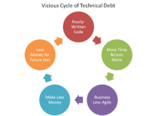Upgrade & Secure Your Future with DevOps, SRE, DevSecOps, MLOps!
We spend hours on Instagram and YouTube and waste money on coffee and fast food, but won’t spend 30 minutes a day learning skills to boost our careers.
Master in DevOps, SRE, DevSecOps & MLOps!
Learn from Guru Rajesh Kumar and double your salary in just one year.
Source:-devblogs.microsoft.com
App Dev Manager Silviano Blea explores the idea of how “technical debt” can work against an organization’s ability to adapt and transform in their DevOps journey.
Technical Debt can be defined as as “the concept in software development that reflects the implied cost of additional rework caused by choosing an easy (limited) and faster solution now instead of a using a better approach that would take longer”. I will also define Technical Code Debt as the IT infrastructure and development artifacts (usually coding) that are created to solve a business problem in the short run instead of applying the best overall solution. It reflects the decisions made under time, technical and/or cultural constraints at a single point in time. This can also mean more Tribal knowledge – The Anti-DevOps Culture gets inserted into a project or environment over time without considering the overall design, architecture or implementation. The additional cost of refactoring or re-implementing a design grows over time just like interest in monetary debt.
Over time, the “debt” grows and requires organizations to eventually pay the debt in full and with compounded interest! Organization must ensure they have a handle on their current technical debt and any cultural habits that might contribute to it. They must ensure technical debt has been rooted out through adopting an awareness of it in their DevOps journey and culture. In my experience, overcoming a project’s technical debt (typically code) has always been vital in a successful DevOps transformation. This is one of the pillars in adopting a true DevOps mindset.
In the days prior to DevOps, keeping and carrying technical debt would almost always win the business case. DevOps has changed this philosophy and cultural mindset. With Agile and DevOps principles & practices, tools like Pull Request (PRs), Coding Peer Reviews, Continuous Integration (CI), Continuous Testing (CT), and Continuous Security (CS) and Continuous Deployment (CD), will allow integration and automation of refactored/re-designed code bases in a repeatable fashion. Since the Agile Manifesto is at the heart of a DevOps transformation, here are the key DevOps cultural points to adopt:
Build it into the plans and sprints. Take the time to remove both small and large technical debt for the greater good of the team. Managers must actively promote and reward this behavior to drive out technical debt. The bigger the debt, the bigger the reward.
Refactor often. If things are difficult or painful to modify in the code, consider re-design and/or re-implementation. This will likely need to be done several times to get an optimal solution. Managers must actively promote and reward this behavior to drive out technical debt.
Take the long-term approach. The goal here is to measure impact rather than activity. It’s not about Source Lines of Code (SLOC) or team metrics (capacity, burndown, velocity), but rather the overall impact these changes can create in the long term. See this as an opportunity rather than mistakes. Managers must actively promote and reward this behavior to drive out technical debt.
For organizations to have a successful DevOps/DevSecOps journey, they must identify and remove the technical debt that impedes this progress. This requires a champion in management to make removing technical debt a priority and reward those that take initiative in removing it for the team. By taking a different approach to technical debt, running toward it rather than away from it, you will setup your organization for success in the DevOps journey and change your culture at the same time. Don’t let any accrued “debt” and “interest” in your DevOps journey derailed your digital and cultural transformation.

 Starting: 1st of Every Month
Starting: 1st of Every Month  +91 8409492687 |
+91 8409492687 |  Contact@DevOpsSchool.com
Contact@DevOpsSchool.com